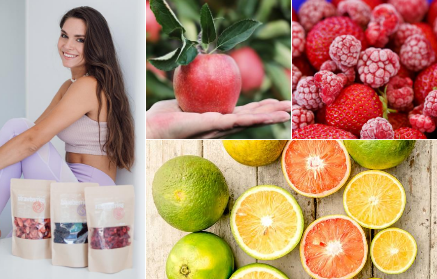Table of Contents
Fruit is rightly considered one of the healthiest crops in the world. It contains a unique number of vitamins, minerals, antioxidants, fiber and many other beneficial nutrients. In addition, it falls into the category of foods that contain a high proportion of water, a higher proportion of fiber and a lower content of calories. Thanks to this, it is a popular dish that supports a healthy lifestyle, but also weight loss itself.
However, you should be cautious when choosing fruit for your reduction menu. Some species contain a high proportion of sugars, which can make it very difficult for you to lose weight. But in general, fruit consumption is associated with lower body weight and a lower risk of health problems caused by overweight or obesity. [1] [2]
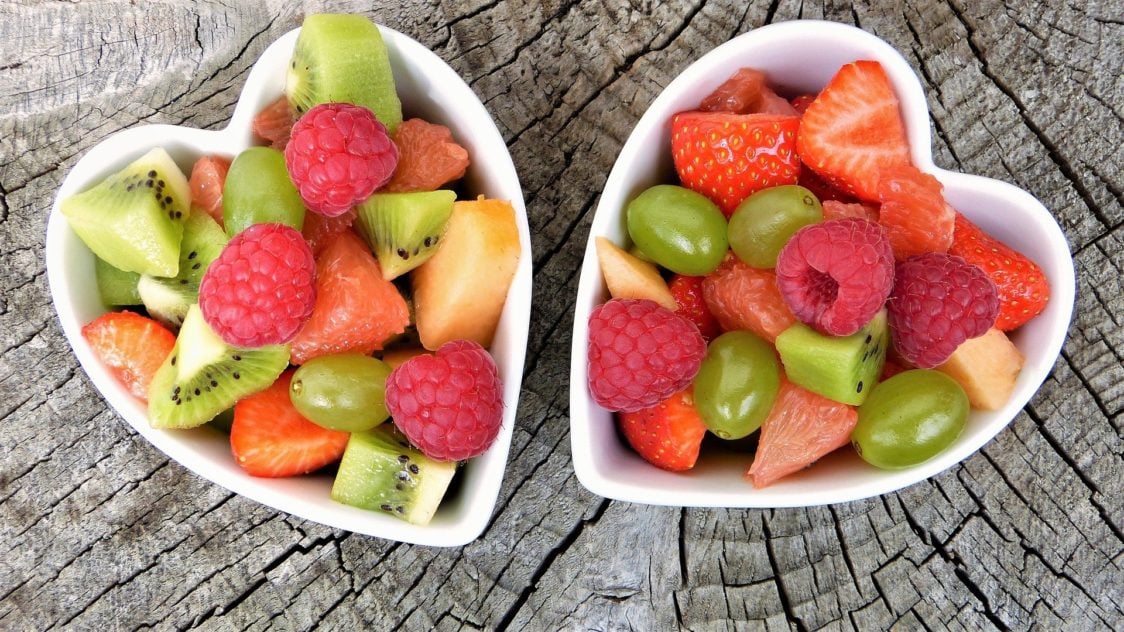
Fruits and weight loss
It is well known that fruit is an integral part of a healthy and balanced diet, especially due to the content of beneficial vitamins and minerals. No wonder, e.g. just one orange can satisfy the daily needs of vitamin C. As we know, it is an extremely important micronutrient for supporting the immune system, producing collagen and ensuring the overall health of the body. You can find out more about it in our article Vitamin C: everything you need to know about it until it’s too late. On the contrary, such a banana, although considered a more caloric fruit, can provide the body with an average of up to 12% of the recommended daily intake of potassium. It helps regulate the activity of nerves, muscles and heart. [6] [1] [2] You can read more about the benefits and need for potassium supplementation in the article 5 of the surprising reasons why potassium is important for athletes.
But how can these sweet crops, full of healthy micronutrients but also carbohydrates, be beneficial in weight loss? This is due to their mentioned nutrients, high water content, fiber content and extremely low calorie content.
However, you should be cautious how the selected fruit is processed. The difference is whether it is fresh, dried or lyophilized fruit. Although fresh fruit contains calories and sugars, due to the presence of water, their occurrence is much lower. On the contrary, when the fruit is dried, water is removed from it, and thus it becomes calorically denser, which means that it may contain more calories, sugars, but also fats. In addition, it removes important vitamins and minerals. On the contrary, lyophilized fruit is a great alternative to dried fruit. It is fruit dried with frost at very low temperatures. Thanks to this technology, water is gently removed from it, but the fruit retains its unique taste and also the necessary vitamins and minerals. At the same time, it contains fewer calories and has a significantly longer consumption. [33]
The fruit contains a low volume of calories
As already mentioned, several fruits contain a low proportion of calories. As a result, consuming them can reduce your total caloric intake, thereby promote the weight loss. In addition, by including low-calorie foods in your diet, such as fruits, you can help create a caloric deficit. This is the key component in your weight loss efforts. That is because a caloric deficit occurs when your daily energy expenditure exceeds your daily energy intake, which automatically causes weight loss. Let’s explain it with an example:
daily intake 2000 kcal – if you burn 2 500 kcal daily = your caloric deficit is 500 kcal = weekly 3 500 kcal = minus 0,45 kg per week. [1] [2] [7] [30]

If you are still hesitant about whether fruit, despite its delicious and sweet taste, is a better alternative to having a snack in terms of calories, here is another example for you. If you replace one 100 g of milk chocolate with a content of 347 calories with 100 g of apples with a proportion of 52 calories, you will save up to 295 kcal per day. In addition, you get beneficial vitamins and minerals and up to 2,4 g of fiber into the body. Milk chocolate offers fiber, but only in the amount of 1,2 g and in addition it fills you with a great number of added sugar and fats. [8]
You might be interested in these products:
Fruit fiber promotes weight loss
There are more than 100 types of bacteria in our intestines. Some are dangerous for our digestion and must be washed out of the body. On the contrary, there are also various types of beneficial bacteria. These play an important role in many aspects of health, including weight management and controlling the levels of sugar in blood. [10] [11]
In order for these bacteria to survive, they need to be nourished sufficiently. This is where fiber plays an extremely important role. Soluble fiber passes through most of the digestive system, mostly unchanged, until it finally reaches friendly intestinal bacteria. They digest it and then convert it into usable energy, which they can also use for other functions associated with weight loss. Such fiber is called prebiotic fiber and can be found in bananas, apples or grapefruit. [1] [2] [9]

Another irreplaceable benefit of fiber in weight loss is its ability to induce a feeling of fullness. [12] Some research suggests that fiber may lead to decreased appetite and consequently lower food intake. This hypothesis was confirmed by one renowned study that has also shown the effect of fiber on lowering the levels of sugar in blood. [13]
To make things even better, in addition to the mentioned benefits, the fruit has also a high water content. This, together with the fiber, forms an exceptional combination that will allow you to eat smaller portions and still achieve a feeling of fullness. One study even showed that consuming foods with a higher water content resulted in a greater feeling of fullness than if you drank water with food. [14]
See an overview of fruits with high fiber content. [8]
| FRUITS RICH IN FIBER | FIBER CONTENT PER 100 G OF FRUIT |
|---|---|
| Passion fruit | 10,4 g |
| Avocado | 6,7 g |
| Raspberries | 6,5 g |
| Blackberries | 5,3 g |
| Pomegranate | 4 g |
| Bananas | 2,6 g |
| Strawberries | 1,8 g |
We remind you that the optimal daily intake of fiber should be approximately 25 to 30 g, depending on gender, weight, age and health condition. From this point of view, you would have to consume about 400 g of raspberries to achieve it. Therefore, it is recommended to include the fruit as part of a healthy and balanced diet rich in fiber, which you also get from other sources.
The fruit contains natural sugars
The sweet taste of the fruit is given by its high content of carbohydrates. However, it should be noted that not every sugar is the same. The fruit contains natural sugar, while common sweet foods contain added, mostly chemically produced sugar. The two types can have very different health effects. [1] [2]
Added sugar is associated with a number of potential health problems, including obesity, diabetes and heart disease. [15] You can read more about these problems and the differences between natural and added sugar in the article Sugar substitutes – which sweetener is best for you ?.
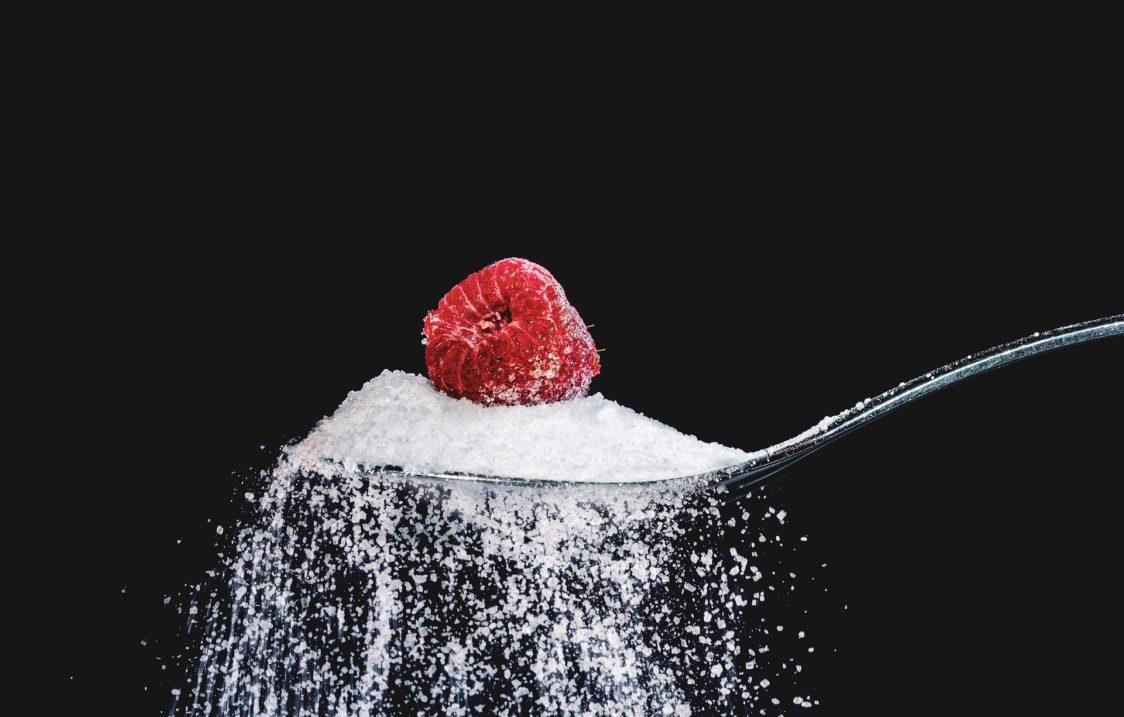
Sugar in fruit contains a mixture of fructose, glucose and sucrose. It is the first mentioned type of monosaccharide sugar that can be a problem. When consumed in large quantities, fructose can be harmful and can contribute to obesity. [16] For this reason, many people think that they will do well by eliminating fruit consumption. However, it is important to distinguish between the huge amount of fructose found in added sugars and its small amounts in fruit.
This is because fructose is only harmful in larger quantities. To reach this amount, you would need to take approximately 25 to 50 g of fructose per day, which is about 714 g of grapefruit. In addition, the high content of fiber and polyphenols in fruits reduces the increase in blood sugar levels caused by glucose, sucrose and fructose. Therefore, the sugar content in fruits is not a problem for healthy people and is certainly a better alternative of snack to weight loss. [16]
See an overview of fruit that contains a minimum amount of sugar: [8]
| FRUITS WITH LOW SUGAR CONTENT | SUGAR CONTENT PER 100 G OF SUGAR |
|---|---|
| Grapefruit | 7 g |
| Strawberries | 4,9 g |
| Blackberries | 4,9 g |
| Raspberries | 4,4 g |
| Lemon | 2,5 g |
| Avocado | 0,7 g |
Fruit with the lowest calorie content
We discussed above the reasons why fruit is simply a “must” food on your way to losing weight. We therefore bring you a list of fruit that has the lowest number of calories, so it is ideal for your reduction diet. [3] [4] [5]
Grapefruit and other citrus fruits
Citrus is generally considered to be one of the best low-calorie fruits, which brings many benefits for our health. One of the best citrus fruits you can add to your diet is grapefruit, for several reasons.
Grapefruit is a tropical citrus fruit known for its sweet and slightly sour to bitter taste. It is extremely rich in vitamins A, C and D, calcium, potassium, antioxidants and fiber, making it one of the healthiest citrus fruits. Moreover, research has shown that consuming grapefruit, thanks to its low number of calories, sugars and fats, can be beneficial for weight loss. They have also shown that it can also have health benefits such as reducing the risk of heart disease. [17] This was also demonstrated by a study that monitored obese people for 12 weeks and the effect of grapefruit and grapefruit juice consumption on their weight. The research resulted in an average of 7,1% weight loss and improvement of cholesterol levels. [19]
Nutritional values of grapefruit per 100 g: [8]
| CALORIES | CARBOHYDRATES | SUGARS | FIBER | PROTEIN | FATS |
|---|---|---|---|---|---|
| 42 kcal | 11 g | 7 g | 1,6 g | 0,8 g | 0,1 g |
Apples
Apples are among the most available fruits in the world. Research shows that they provide many health benefits, such as reducing the risk of developing diabetes. They can boast an extremely high water content, which causes feelings of fullness and reduces the caloric density of food. [20]
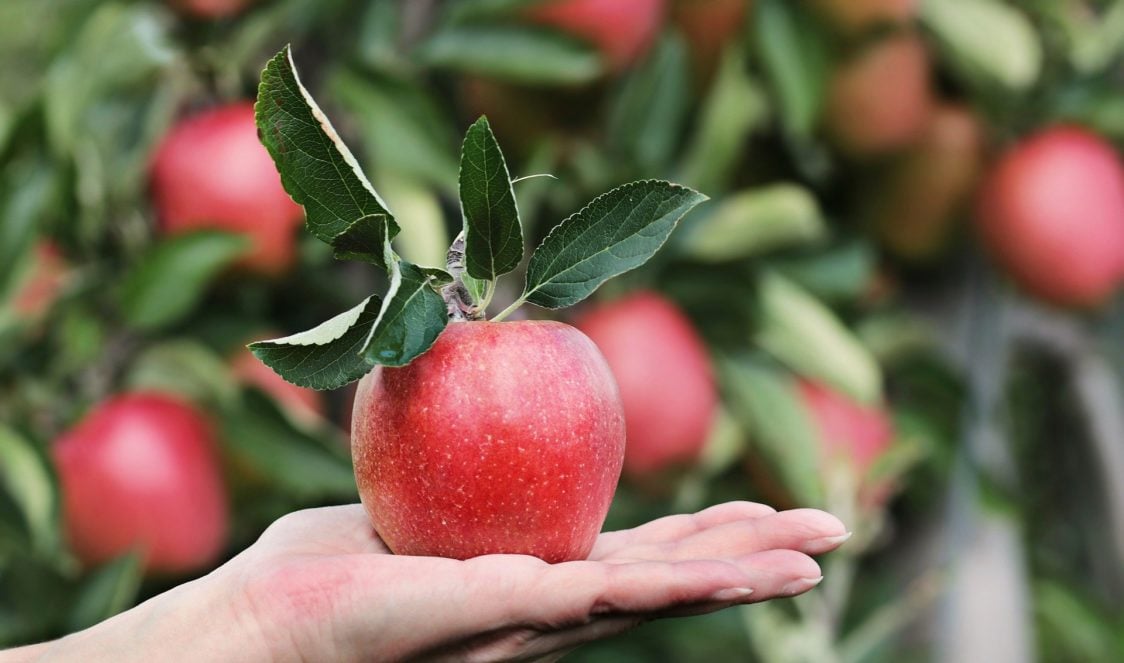
One large study in more than 120 000 individuals found that consuming apples caused them to lose an average of 0,56 kg per day. The study lasted 4 years and, among other things, showed that eating whole apples was more effective in reducing weight, not juices. [21] [22]
Nutritional values of apples per 100 g: [8]
| CALORIES | CARBOHYDRATES | SUGARS | FIBER | PROTEIN | FATS |
|---|---|---|---|---|---|
| 52 kcal | 14 g | 10 g | 2,4 g | 0,3 g | 0,2 g |
Kiwi
Kiwi is a small green or yellow fruit with a brown skin and small black seeds. It is extremely rich in vitamins C and K, fiber, potassium, antioxidants, and as one of the few fruits also folic acid (folate). It has a lower energy density, making it an ideal fruit in reduction diets. [23] This was also demonstrated by a 12-week study which has shown that kiwi consumption causes an increase in vitamin C in the body and at the same time a decrease in waist circumference of 3,1 cm. [24] Other studies also suggest that kiwi can help control sugar levels in blood, improve cholesterol and promote intestinal health. [25]
Nutritional values of kiwi per 100 g: [8]
| calories | carbohydrates | sugars | Fiber | Protein | Fats |
|---|---|---|---|---|---|
| 61 kcal | 15 g | 9 g | 3 g | 1,1 g | 0,5 g |
Bananas
Although bananas have more calories compared to apples or grapefruit, they are also much thicker and contain a lot of fiber. Thanks to this, we also include them in this list, as they cause a feeling of fullness and satisfaction of hunger. They also supply many vitamins and minerals, such as potassium, magnesium, manganese, antioxidants, and vitamins A, B6, and C. In addition, one renowned study showed that daily consumption of bananas lowered blood sugar and cholesterol in people with high cholesterol levels. [26]
Nutritional values of bananas per 100 g: [8]
| calories | carbohydrates | sugars | fiber | protein | fats |
|---|---|---|---|---|---|
| 89 kcal | 23 g | 12 g | 2,6 g | 1,1 g | 0,3 g |
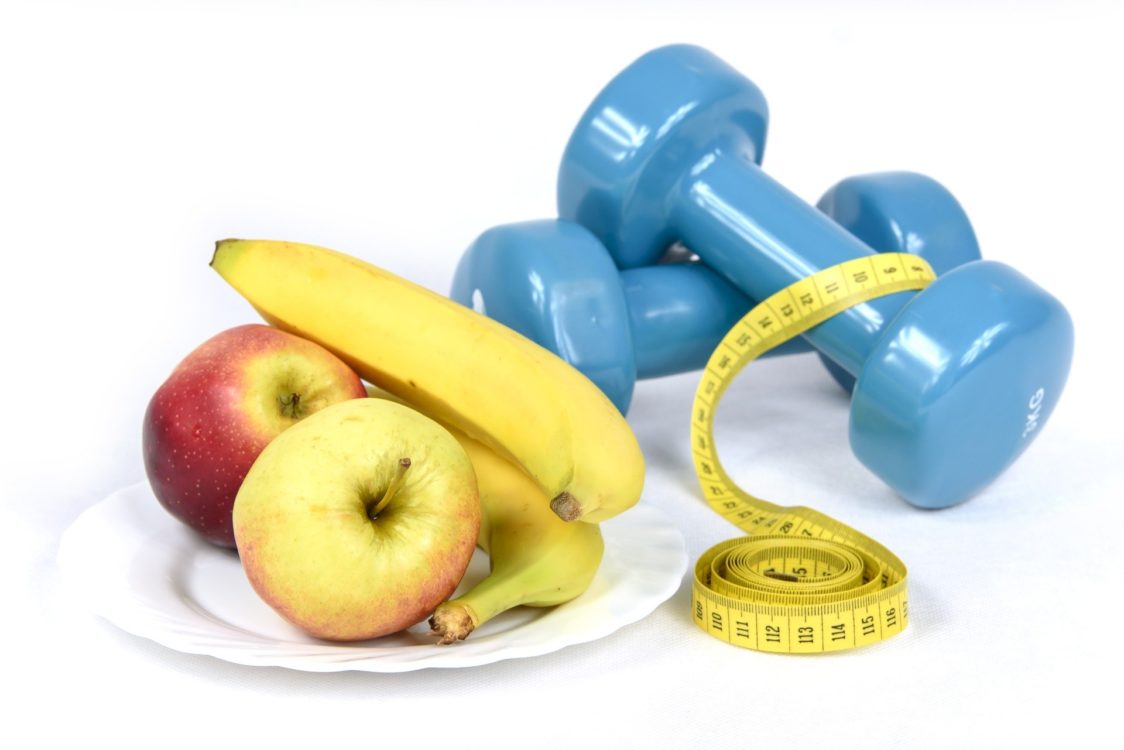
Pineapple
Pineapple is one of the healthiest fruits in the world and is a popular ingredient in many weight loss products. This is due to its low caloric values, but also to the fact that it does not contain saturated fats or trans fatty acids. On the contrary, it provides thiamine, magnesium, vitamin B6, vitamin C, riboflavin, niacin, copper and iron. So, it is really a bomb loaded with vitamins and minerals, which also evokes a feeling of fullness due to its high fiber content. [27]
In addition, pineapple is a great source of digestive enzymes, specifically bromelain. It supports the proper functioning of the intestines, the breakdown of proteins into amino acids and also helps in the digestion of fats. Thanks to the efficient digestion of fat stores, bromelain is an indispensable part of reduction diets. [32]
Nutritional values of pineapple per 100 g: [8]
| calories | carbohydrates | sugars | fiber | protein | fats |
|---|---|---|---|---|---|
| 50 kcal | 13 g | 10 g | 1,4 g | 0,5 g | 0,1 g |
Berries – strawberries, raspberries, blueberries or blackberries
Berries are deliciously sweet fruits full of vitamins, minerals, fiber, polyphenols and antioxidants. They can also boast low calorie and fat content and extremely low sugar proportion.
In addition, such strawberries have on their surface as one of the few fruit seeds, which are a great source of omega-3 fatty acids. A bowl of fresh strawberries can also provide you with a high amount of fiber that induces a feeling of fullness. Research has also shown that they have beneficial effects in reducing belly fat. [28] [31]

Nutritional values of strawberries per 100 g: [8]
| calories | carbohydrates | sugars | fiber | protein | fats |
|---|---|---|---|---|---|
| 33 kcal | 8 g | 4,9 g | 2 g | 0,7 g | 0,3 g |
Melon
Although melon is a type of fruit vegetable, thanks to its juicy and sweet flesh we can also include it as a fruit. It has a low calorie content thanks to its extremely rich water content. It is one of the most watery crops, which will help you maintain proper hydration, among other things. As much as 90% of the weight of melon is pure water. In addition, melon is a great antioxidant that will rid you of excess harmful substances. It also boasts a high content of vitamins and minerals, such as potassium, magnesium or vitamins A and C, which are involved in many processes in our body. [34] Its advantage is also the content of the amino acid arginine, which effectively helps to burn excess fats. [35]
Nutritional values of melon per 100 g: [8]
| calories | carbohydrates | sugars | fiber | protein | fats |
|---|---|---|---|---|---|
| 34 kcal | 8 g | 8 g | 0,9 g | 0,8 g | 0,2 g |
So, do you still have doubts about the impact of fruit on weight loss? Remember that if you want to lose weight, but you will have an unbeatable taste for sweets, you should reach for an apple or other sweet fruit. Not only will you consume far fewer calories, fats and sugars than chocolate, but you will also enrich your body with many beneficial substances.
Do you consume fruit as a substitute for sweet treats? What fruit is your favorite and why? Share your opinion in the comments and don’t forget to share the article.
[1] Rachael Link, MS, RD – Does Fruit Help You Lose Weight? – https://www.healthline.com/nutrition/fruit-and-weight-loss
[2] Dr. Mike Roussell – Is Fruit Still Part of a Healthy Diet? – https://www.shape.com/weight-loss/food-weight-loss/ask-diet-doctor-fruit-really-free-diet-food
[3] These 12 Fruits Can Help You Lose Weight – https://food.ndtv.com/weight-loss/these-7-fruits-can-help-you-lose-weight-1340094
[4] Elise Mandl, BSc, APD – The 11 Best Fruits for Weight Loss – https://www.healthline.com/nutrition/best-weight-loss-fruits
[5] Jasmine Gomez – 11 Best Fruits For Weight Loss, According To A Nutritionist – https://www.womenshealthmag.com/weight-loss/g31903094/fruits-for-weight-loss/
[6] Eva S Wintergerst, Silvia Maggini, Dietrich H Hornig – Immune-enhancing role of vitamin C and zinc and effect on clinical conditions – https://pubmed.ncbi.nlm.nih.gov/16373990/
[7] Kevin D. Hall – What is the Required Energy Deficit per unit Weight Loss? – https://www.ncbi.nlm.nih.gov/pmc/articles/PMC2376744/
[8] FoodData Central – https://ndb.nal.usda.gov/ndb/search/list?qlookup=09003
[9] Joe Leech, MS – Fiber Can Help You Lose Weight — But Only A Specific Type – https://www.healthline.com/nutrition/fiber-can-help-you-lose-weight
[10] Ruth E Ley, Peter J Turnbaugh, Samuel Klein, Jeffrey I Gordon – Microbial ecology: human gut microbes associated with obesity – https://pubmed.ncbi.nlm.nih.gov/17183309/
[11] Giovanni Musso, Roberto Gambino, Maurizio Cassader – Obesity, diabetes, and gut microbiota: the hygiene hypothesis expanded? – https://pubmed.ncbi.nlm.nih.gov/20876708/
[12] Mette Kristensen, Morten Georg Jensen – Dietary fibres in the regulation of appetite and food intake. Importance of viscosity – https://pubmed.ncbi.nlm.nih.gov/21115081/
[13] Rania Abou Samra, G Harvey Anderson – Insoluble cereal fiber reduces appetite and short-term food intake and glycemic response to food consumed 75 min later by healthy men – https://pubmed.ncbi.nlm.nih.gov/17921373/
[14] B J Rolls, E A Bell, M L Thorwart – Water incorporated into a food but not served with a food decreases energy intake in lean women – https://pubmed.ncbi.nlm.nih.gov/10500012/t/
[15] James M Rippe, Theodore J Angelopoulos – Sugars, obesity, and cardiovascular disease: results from recent randomized control trials – https://pubmed.ncbi.nlm.nih.gov/27418186/
[16] Salwa W Rizkalla – Health implications of fructose consumption: A review of recent data – https://www.ncbi.nlm.nih.gov/pmc/articles/PMC2991323/
[17] Ken Fujioka, Frank Greenway, Judy Sheard, Yu Ying – The effects of grapefruit on weight and insulin resistance: relationship to the metabolic syndrome – https://pubmed.ncbi.nlm.nih.gov/16579728/
[18] Martí Juanola-Falgarona, Jordi Salas-Salvadó, Núria Ibarrola-Jurado, Antoni Rabassa-Soler, Andrés Díaz-López, Marta Guasch-Ferré, Pablo Hernández-Alonso, Rafael Balanza, Mònica Bulló – Effect of the glycemic index of the diet on weight loss, modulation of satiety, inflammation, and other metabolic risk factors: a randomized controlled trial – https://pubmed.ncbi.nlm.nih.gov/24787494/
[19] Heidi J Silver, Mary S Dietrich, Kevin D Niswender – Effects of grapefruit, grapefruit juice and water preloads on energy balance, weight loss, body composition, and cardiometabolic risk in free-living obese adults – https://pubmed.ncbi.nlm.nih.gov/21288350/
[20] Monica L Bertoia, Kenneth J Mukamal, Leah E Cahill, Tao Hou, David S Ludwig, Dariush Mozaffarian, Walter C Willett, Frank B Hu, Eric B Rimm – Changes in Intake of Fruits and Vegetables and Weight Change in United States Men and Women Followed for Up to 24 Years: Analysis from Three Prospective Cohort Studies – https://pubmed.ncbi.nlm.nih.gov/26394033/
[21] Richard D Mattes, Wayne W Campbell – Effects of food form and timing of ingestion on appetite and energy intake in lean young adults and in young adults with obesity – https://pubmed.ncbi.nlm.nih.gov/19248858/
[22] Maria Conceição de Oliveira, Rosely Sichieri, Anibal Sanchez Moura – Weight loss associated with a daily intake of three apples or three pears among overweight women – https://pubmed.ncbi.nlm.nih.gov/12620529/
[23] Lynley Drummond – The composition and nutritional value of kiwifruit – https://pubmed.ncbi.nlm.nih.gov/23394981/
[24] Lynley Drummond – The composition and nutritional value of kiwifruit – https://www.ncbi.nlm.nih.gov/pmc/articles/PMC6073280/
[25] Suman Mishra, Haley Edwards, Duncan Hedderley, John Podd and John Monro – Kiwifruit Non-Sugar Components Reduce Glycaemic Response to Co-Ingested Cereal in Humans – https://www.ncbi.nlm.nih.gov/pmc/articles/PMC5707667/
[26] Ratchada Cressey, Warunee Kumsaiyai, Ampika Mangklabruks – Daily consumption of banana marginally improves blood glucose and lipid profile in hypercholesterolemic subjects and increases serum adiponectin in type 2 diabetic patients – https://pubmed.ncbi.nlm.nih.gov/25651610/
[27] Kelly Kennedy, RD – 8 Scientific Health Benefits of Pineapple – https://www.everydayhealth.com/diet-nutrition/8-reasons-eat-pineapple/
[28] Sushmita Sengupta – Strawberry For Weight Loss: 5 Ways It Helps You Shed Kilos – https://food.ndtv.com/food-drinks/strawberries-for-weight-loss-5-ways-it-helps-you-shed-kilos-1890890
[29] Sadia Afrin, Massimiliano Gasparrini, Tamara Y Forbes-Hernandez, Patricia Reboredo-Rodriguez, Bruno Mezzetti, Alfonso Varela-López, Francesca Giampieri, Maurizio Battino – Promising Health Benefits of the Strawberry: A Focus on Clinical Studies – https://pubmed.ncbi.nlm.nih.gov/27172913/
[30] Gavin Van De Walle, MS, RD – What Is a Calorie Deficit, and How Much of One Is Healthy? – https://www.healthline.com/nutrition/calorie-deficit
[31] Satya P. Sharma, Hea J. Chung, Hyeon J. Kim and Seong T. Hong – Paradoxical Effects of Fruit on Obesity – https://www.ncbi.nlm.nih.gov/pmc/articles/PMC5084020/
[32] Debra Sullivan, Ph.D., MSN, R.N., CNE, COI – Bromelain – https://www.healthline.com/health/bromelain
[33] Cynthia Sass – Is Dried Fruit Fattening? – https://www.shape.com/healthy-eating/dried-fruit-fattening
[34] Jessie Szalay – Watermelon: Health Benefits, Risks & Nutrition Facts – https://www.livescience.com/46019-watermelon-nutrition.html
[35] Julie K Collins, Guoyao Wu, Penelope Perkins-Veazie, Karen Spears, P Larry Claypool, Robert A Baker, Beverly A Clevidence – Watermelon consumption increases plasma arginine concentrations in adults – https://pubmed.ncbi.nlm.nih.gov/17352962/

